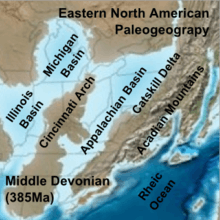Palaeogeography
Not to be confused with
Palaeography, the study of ancient handwriting.

Paleogeographic reconstruction showing the Appalachian Basin area during the
Middle Devonian period.
[1]Palaeogeography (or paleogeography) is the study of historical geography, generally physical landscapes. Palaeogeography can also include the study of human or cultural environments. When the focus is specifically on the study of landforms, the term paleogeomorphology is sometimes used instead.
Paleogeography yields information that is crucial to scientific understanding in a variety of contexts. For example, paleogeographic analysis of sedimentary basins plays a key role in the field of petroleum geology, because the ancient geomorphological environments of the Earth's surface are preserved in the stratigraphic record. Paleogeographers also study the sedimentary environment associated with fossils for clues to the evolutionary development of extinct species. And paleogeographic evidence contributed to the development of continental drift theory, and continues to inform current plate tectonic theories, yielding information about the shape and latitudinal location of supercontinents such as Pangaea and ancient oceans such as Panthalassa, thus enabling the reconstruction of prehistoric continents and oceans.
See also
Further reading
References
External links

